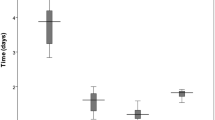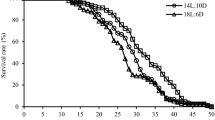Abstract
Two-spotted spider mite is a major pest of many agricultural and ornamental crops worldwide. Some reports have indicated that application of neonicotinoid insecticides may lead to increased fecundity of this pest. If this is found to be true, the use of these pesticides may cause an outbreak of spider mite populations. Sublethal effects of three neonicotinoids, namely thiacloprid, acetamiprid and thiamethoxam were studied on T. urticae adults at field recommended doses. The experiments were carried out using bean leaf pieces in plastic Petri dishes. The adult mites were treated using two methods: (1) drench application and (2) spraying of leaves with Potter Spray Tower. Our results indicated that all neonicotinoids tested increased T. urticae population. In both treatment methods, acetamiprid treated mites had the highest intrinsic rate of population increase (rm) and finite rate of population increase (λ); and the lowest mean generation time (T) and doubling time among the treatments. If similar results are obtained from greenhouse and field trials, the use of these insecticides requires necessary precautions such as avoiding repeated use of neonicotinoid insecticide for controlling insect pests.


Similar content being viewed by others
References
Ako M, Borgemeister C, Poehling HM, Elbert A, Nauen R (2004) Effects of neonicotinoid insecticides on the bionomics of two-spotted spider mite Tetranychus urticae Koch (Acari: Tetranychidae). J Econ Entomol 97:1587–1594
Andrewartha H, Birch L (1954) The distribution and abundance of animals. University of Chicago Press, Chicago
Bechmann RK (1994) Use of life tables and LC50 tests to evaluate chronic and acute toxicity effects of copper on the marine copepod Tisbe furcata (Baird). Environ Toxicol Chem 13:1509–1517
Beers EH, Himmel PD (2002) Effect of chloronicotinyl insecticides on phytophagous and predatory mite populations in a cover spray program. In: Proceedings of the 76th annual western Orchard pest and diseases management conference, Hilton Hotel Portland, OR, 9–11 Jan 2002
Beers EH, Brunner JF, Dunley JE, Doerr M, Granger K (2005) Role of neonicotinyl insecticides in Washington apple integrated pest management Part II. Nontarget effects on integrated mite control. J Insect Sci 5:16. http://insectscience.org/5.16. Accessed 17 Mar 2012
Bolland HR, Gutierrez J, Flechtmann CHW (1998) World catalogue of the spider mite family (Acari: Tetranychidae) with references to taxonomy, synonymy, host pests and distribution. Academic Publ. Brill, Leiden
Carey JR (1993) Applied demography for biologist. Oxford University Press, New York
Castagnoli M, Liguori M, Simoni S, Duso C (2005) Toxicity of some insecticides to Tetranychus urticae, Neoseiulus californicus and Tydeus californicus. BioControl 50:611–622
Choi W, Lee S, Park H, Ahn Y (2004) Toxicity of plant essential oils to Tetranychus urticae (Acari: Tetranychidae) and Phytoseiulus persimilis (Acari: Phytoseiidae). J Econ Entomol 97:553–558
Forbes VE, Calow P (1999) Is the per capita rate of increase a good measure of population-level effects in ecotoxicology? Environ Toxicol Chem 18:1544–1556
Hardin MR, Benrey B, Colt M, Lamp WO, Roderick GK, Barbosa P (1995) Arthropod pest resurgence: an overview of potential mechanisms. Crop Prot 14:3–18
Helle W, Sabelis MW (1985) Spider mites. Their biology, natural enemies and control. Elsevier Science, Amsterdam
Holland JM, Chapman RB (1995) Comparative toxic and sublethal effects of fluvalinate on two-spotted spider mite and European red mite. Exp Appl Acarol 19:549–570
James DG (1997) Imidacloprid increases egg production in Amblyseius victoriensis (Acari: Phytoseiidae). Exp Appl Acarol 21:75–82
James DG, Price TS (2002) Fecundity in two-spotted spider mite (Acari: Tetranychidae) is increased by direct and systemic exposure to imidacloprid. J Econ Entomol 95:729–732
Jeschke P, Nauen R (2008) Neonicotinoids—from zero to hero in insecticide chemistry. Pest Manag Sci 64:1084–1098
Maia AHN, Alferdo JBL, Campanhola C (2000) Statistical inference on associated fecundity life table parameters using jackknife technique: computational aspects. J Econ Entomol 93:511–518
Marcic D (2003) The effects of clofentezine on life-table parameters in two-spotted spider mite Tetranychus urticae. Exp Appl Acarol 30:249–263
Marcic D (2005) Sublethal effects of tebufenpyrad on the eggs and immatures of two-spotted spider mite, Tetranychus urticae. Exp Appl Acarol 36:177–185
Marcic D (2007) Sublethal effects of spirodiclofen on life history and life-table parameters of two-spotted spider mite (Tetranychus urticae). Exp Appl Acarol 42:121–129
Marcic D, Medo I (2014) Acaricidal activity and sublethal effects of an oxymatrine-based biopesticide on two-spotted spider mite (Acari: Tetranychidae). Exp Appl Acarol 64:375–391
Marcic D, Ogurlic I, Mutavdzic S, Peric P (2010) The effects of spiromesifen on life history traits and population growth of two-spotted spider mite (Acari: Tetranychidae). Exp Appl Acarol 50:255–267
Meyer JS, Ingersoll CG, McDonald LL, Boyce MS (1986) Estimating uncertainty in population growth rates: jackknife vs bootstrap techniques. Ecology 67:1150–1166
Pozzebon A, Duso C, Tirello P, Ortiz PB (2011) Toxicity of thiamethoxam to Tetranychus urticae Koch and Phytoseiulus persimilis Athias-Henriot (Acari Tetranychidae, Phytoseiidae) through different routes of exposure. Pest Manag Sci 67:352–359
SAS Institute (2004) SAS software version 9.1. SAS Institute, Cary
Smith JF, Catchot AL, Musser FR, Gore J (2013) Effects of aldicarb and neonicotinoid seed treatments on twospotted spider mite on cotton. J Econ Entomol 106:807–815
Stark JD, Banks JE (2003) Population-level effects of pesticides and other toxicants on arthropods. Annu Rev Entomol 48:505–519
Stark JD, Wennergren U (1995) Can population effects of pesticides be predicted from demographic toxicological studies? J Econ Entomol 88:1089–1096
Szczepaniec A (2009) Mechanisms underlying outbreaks of spider mites following applications of imidacloprid. Dissertation, University of Maryland
Tomczyk A, Kropczynska A (1985) Effects on the host plants. In: Helle W, Sabelis MW (eds) Spider mites, their biology, natural enemies and control. Elsevier, Amsterdam, pp 317–329
Zeng CX, Wang JJ (2010) Influence of exposure to imidacloprid on survivorship, reproduction and vitellin content of the carmine spider mite, Tetranychus cinnabarinus. J Insect Sci 10:20. doi:10.1673/031.010.2001
Acknowledgments
We are thankful to Dr. Ghasem Askari Saryazdi for technical assistance and Raziyeh Mansouri for help in analysis of the data. We also thank the University of Tabriz for financial support of this research.
Conflict of interest
The authors verify that the manuscript submitted is incompliance with ethical standards and there is no potential conflict of interest of any kind.
Author information
Authors and Affiliations
Corresponding author
Rights and permissions
About this article
Cite this article
Barati, R., Hejazi, M.J. Reproductive parameters of Tetranychus urticae (Acari: Tetranychidae) affected by neonicotinoid insecticides. Exp Appl Acarol 66, 481–489 (2015). https://doi.org/10.1007/s10493-015-9910-7
Received:
Accepted:
Published:
Issue Date:
DOI: https://doi.org/10.1007/s10493-015-9910-7




